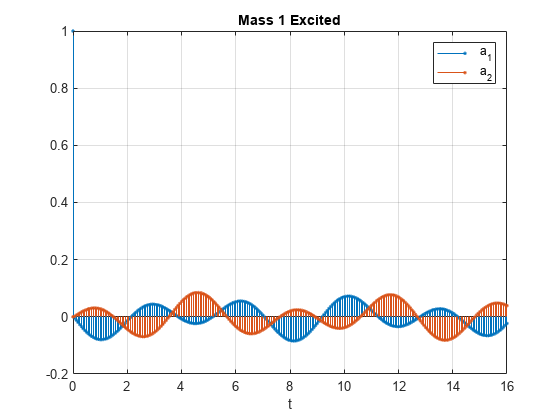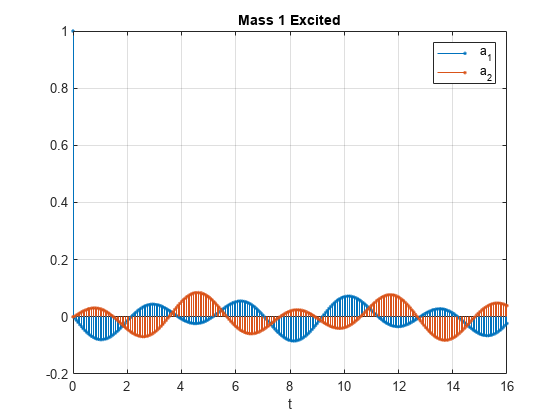ss2tf - Convert state-space representation to transfer function - MATLAB (original) (raw)
Convert state-space representation to transfer function
Syntax
Description
[[b](#buh3rcg-b),[a](#buh3rcg-a)] = ss2tf([A](#buh3rcg-A),[B](#buh3rcg-B),[C](#buh3rcg-C),[D](#buh3rcg-D)) converts a state-space representation of a system into an equivalent transfer function. ss2tf returns the Laplace-transform transfer function for continuous-time systems and the Z-transform transfer function for discrete-time systems.
[[b](#buh3rcg-b),[a](#buh3rcg-a)] = ss2tf([A](#buh3rcg-A),[B](#buh3rcg-B),[C](#buh3rcg-C),[D](#buh3rcg-D),[ni](#buh3rcg-ni)) returns the transfer function that results when the nith input of a system with multiple inputs is excited by a unit impulse.
Examples
A one-dimensional discrete-time oscillating system consists of a unit mass, m, attached to a wall by a spring of unit elastic constant. A sensor samples the acceleration, a, of the mass at Fs=5 Hz.

Generate 50 time samples. Define the sampling interval Δt=1/Fs.
Fs = 5; dt = 1/Fs; N = 50; t = dt*(0:N-1);
The oscillator can be described by the state-space equations
x(k+1)=Ax(k)+Bu(k),y(k)=Cx(k)+Du(k),
where x=(rv)T is the state vector, r and v are respectively the position and velocity of the mass, and the matrices
A=(cosΔtsinΔt-sinΔtcosΔt),B=(1-cosΔtsinΔt),C=(-10),D=(1).
A = [cos(dt) sin(dt);-sin(dt) cos(dt)]; B = [1-cos(dt);sin(dt)]; C = [-1 0]; D = 1;
The system is excited with a unit impulse in the positive direction. Use the state-space model to compute the time evolution of the system starting from an all-zero initial state.
u = [1 zeros(1,N-1)];
x = [0;0]; for k = 1:N y(k) = Cx + Du(k); x = Ax + Bu(k); end
Plot the acceleration of the mass as a function of time.
stem(t,y,'filled') xlabel('t')

Compute the time-dependent acceleration using the transfer function H(z) to filter the input. Plot the result.
[b,a] = ss2tf(A,B,C,D); yt = filter(b,a,u);
stem(t,yt,'filled') xlabel('t')

The transfer function of the system has an analytic expression:
H(z)=1-z-1(1+cosΔt)+z-2cosΔt1-2z-1cosΔt+z-2.
Use the expression to filter the input. Plot the response.
bf = [1 -(1+cos(dt)) cos(dt)]; af = [1 -2*cos(dt) 1]; yf = filter(bf,af,u);
stem(t,yf,'filled') xlabel('t')

The result is the same in all three cases.
An ideal one-dimensional oscillating system consists of two unit masses, m1 and m2, confined between two walls. Each mass is attached to the nearest wall by a spring of unit elastic constant. Another such spring connects the two masses. Sensors sample a1 and a2, the accelerations of the masses, at Fs=16 Hz.

Specify a total measurement time of 16 s. Define the sampling interval Δt=1/Fs.
Fs = 16; dt = 1/Fs; N = 257; t = dt*(0:N-1);
The system can be described by the state-space model
x(n+1)=Ax(n)+Bu(n),y(n)=Cx(n)+Du(n),
where x=(r1v1r2v2)T is the state vector and ri and vi are respectively the location and the velocity of the ith mass. The input vector u=(u1u2)T and the output vector y=(a1a2)T. The state-space matrices are
A=exp(AcΔt),B=Ac-1(A-I)Bc,C=(-201010-20),D=I,
the continuous-time state-space matrices are
Ac=(0100-2010000110-20),Bc=(00100001),
and I denotes an identity matrix of the appropriate size.
Ac = [0 1 0 0; -2 0 1 0; 0 0 0 1; 1 0 -2 0]; A = expm(Ac*dt); Bc = [0 0; 1 0; 0 0; 0 1]; B = Ac(A-eye(4))*Bc; C = [-2 0 1 0; 1 0 -2 0]; D = eye(2);
The first mass, m1, receives a unit impulse in the positive direction.
ux = [1 zeros(1,N-1)]; u0 = zeros(1,N); u = [ux;u0];
Use the model to compute the time evolution of the system starting from an all-zero initial state.
x = [0 0 0 0]'; y = zeros(2,N);
for k = 1:N y(:,k) = Cx + Du(:,k); x = Ax + Bu(:,k); end
Plot the accelerations of the two masses as functions of time.
stem(t,y','.') xlabel('t') legend('a_1','a_2') title('Mass 1 Excited') grid

Convert the system to its transfer function representation. Find the response of the system to a positive unit impulse excitation on the first mass.
[b1,a1] = ss2tf(A,B,C,D,1); y1u1 = filter(b1(1,:),a1,ux); y1u2 = filter(b1(2,:),a1,ux);
Plot the result. The transfer function gives the same response as the state-space model.
stem(t,[y1u1;y1u2]','.') xlabel('t') legend('a_1','a_2') title('Mass 1 Excited') grid

The system is reset to its initial configuration. Now the other mass, m2, receives a unit impulse in the positive direction. Compute the time evolution of the system.
u = [u0;ux];
x = [0;0;0;0]; for k = 1:N y(:,k) = Cx + Du(:,k); x = Ax + Bu(:,k); end
Plot the accelerations. The responses of the individual masses are switched.
stem(t,y','.') xlabel('t') legend('a_1','a_2') title('Mass 2 Excited') grid

Find the response of the system to a positive unit impulse excitation on the second mass.
[b2,a2] = ss2tf(A,B,C,D,2); y2u1 = filter(b2(1,:),a2,ux); y2u2 = filter(b2(2,:),a2,ux);
Plot the result. The transfer function gives the same response as the state-space model.
stem(t,[y2u1;y2u2]','.') xlabel('t') legend('a_1','a_2') title('Mass 2 Excited') grid

Input Arguments
State matrix, specified as a matrix. If the system has p inputs and q outputs and is described by n state variables, then A is _n_-by-n.
Data Types: single | double
Input-to-state matrix, specified as a matrix. If the system has p inputs and q outputs and is described by n state variables, then B is _n_-by-p.
Data Types: single | double
State-to-output matrix, specified as a matrix. If the system has p inputs and q outputs and is described by n state variables, then C is _q_-by-n.
Data Types: single | double
Feedthrough matrix, specified as a matrix. If the system has p inputs and q outputs and is described by n state variables, then D is _q_-by-p.
Data Types: single | double
Input index, specified as an integer scalar. If the system has p inputs, use ss2tf with a trailing argument ni = 1, …, p to compute the response to a unit impulse applied to the nith input.
Data Types: single | double
Output Arguments
Transfer function numerator coefficients, returned as a vector or matrix. If the system has p inputs and q outputs and is described by n state variables, then b is _q_-by-(n + 1) for each input. The coefficients are returned in descending powers of s or z.
Transfer function denominator coefficients, returned as a vector. If the system has p inputs and q outputs and is described by n state variables, then a is 1-by-(n + 1) for each input. The coefficients are returned in descending powers of s or z.
More About
- For discrete-time systems, the state-space matrices relate the state vector x, the input u, and the output y through
The transfer function is the Z-transform of the system’s impulse response. It can be expressed in terms of the state-space matrices as - For continuous-time systems, the state-space matrices relate the state vector x, the input u, and the output y through
The transfer function is the Laplace transform of the system’s impulse response. It can be expressed in terms of the state-space matrices as
Version History
Introduced before R2006a
See Also
latc2tf (Signal Processing Toolbox) | sos2tf (Signal Processing Toolbox) | ss2sos (Signal Processing Toolbox) | ss2zp (Signal Processing Toolbox) | tf2ss (Signal Processing Toolbox) | zp2tf (Signal Processing Toolbox)